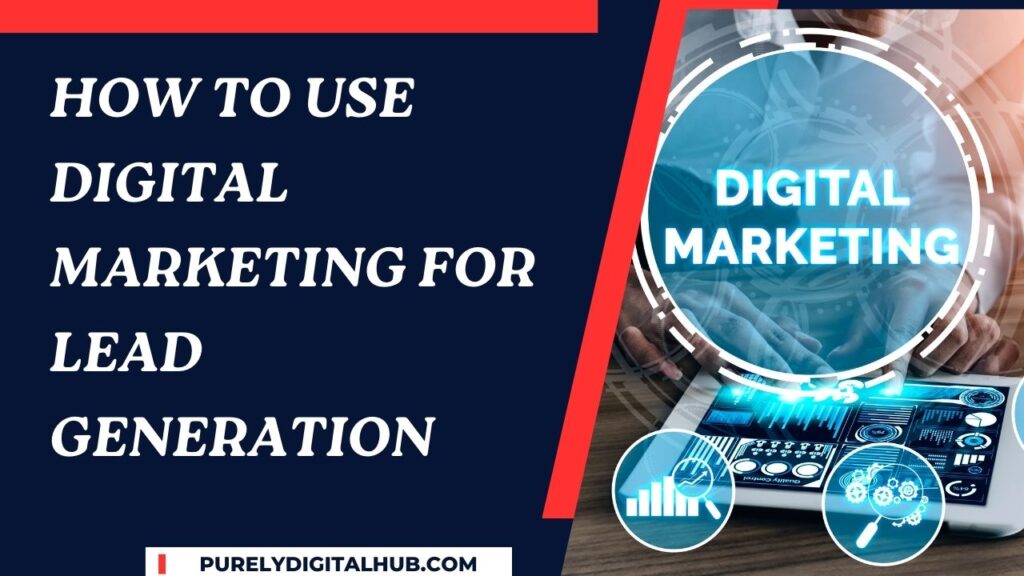Lead generation is the lifeblood of any business aiming to grow and thrive in a competitive marketplace. Digital marketing has revolutionized how businesses attract, nurture, and convert leads. By leveraging a combination of strategies, tools, and platforms, businesses can generate quality leads effectively. This guide explores actionable steps to harness digital marketing for lead generation.
Understanding Lead Generation in Digital Marketing
Lead generation involves attracting potential customers (leads) who show interest in your products or services. Digital marketing uses online platforms to connect with these prospects and guide them through the sales funnel.
Why Digital Marketing is Essential for Lead Generation:
- Global Reach: Access a broader audience.
- Cost Efficiency: Optimize marketing budgets.
- Personalization: Tailor messages to specific customer needs.
Strategies for Using Digital Marketing to Generate Leads
1. Leverage Content Marketing
Content marketing focuses on creating and sharing valuable content to attract and engage your audience. Blogs, eBooks, videos, and infographics can establish authority and encourage visitors to share their contact information.
Tips for Content Marketing Lead Generation:
- Use lead magnets like free guides or checklists in exchange for email addresses.
- Optimize content with relevant keywords for better visibility.
- Add CTAs (calls-to-action) like “Download Now” or “Subscribe” to drive engagement.
| Content Type | Lead Generation Benefit |
|---|---|
| Blog Posts | Increases organic traffic |
| eBooks | Captures contact details |
| Videos | Engages visual learners |
2. Optimize Your Website for Lead Generation
Your website is a key component of your digital marketing strategy. Optimize it to convert visitors into leads by:
- Creating landing pages with lead capture forms.
- Adding clear CTAs across your site.
- Ensuring fast load times and mobile responsiveness.
| Website Element | Optimization Tip |
|---|---|
| Landing Pages | Use compelling headlines |
| Forms | Keep fields minimal |
| Mobile Design | Ensure responsiveness |
3. Utilize Social Media Marketing
Social media platforms like Facebook, LinkedIn, and Instagram are powerful for lead generation. They allow businesses to connect with audiences, share content, and run targeted ads.
Effective Social Media Tactics:
- Use paid ads with lead generation forms (e.g., Facebook Lead Ads).
- Host webinars or live Q&A sessions to engage followers.
- Share gated content requiring users to provide contact information.
| Platform | Lead Generation Strategy |
|---|---|
| B2B lead generation with InMail | |
| Targeted lead ads | |
| Interactive stories with CTAs |
4. Invest in Pay-Per-Click (PPC) Advertising
PPC advertising allows you to reach potential customers actively searching for your services. Platforms like Google Ads and Bing Ads enable precise targeting.
Best Practices for PPC Campaigns:
- Use keyword research to target high-intent search terms.
- Optimize ad copy with clear CTAs and benefits.
- Direct traffic to optimized landing pages.
| Metric | Why It Matters |
|---|---|
| Click-Through Rate | Measures ad relevance |
| Conversion Rate | Assesses lead quality |
| Cost Per Lead | Optimizes budget allocation |
5. Implement Email Marketing
Email marketing remains a powerful tool for nurturing leads. Build segmented email lists to send personalized campaigns that address specific pain points.
Tips for Email Marketing Success:
- Use automation to send timely follow-ups.
- Include engaging subject lines and CTAs.
- Track metrics like open rates and click-through rates.
6. Harness the Power of SEO
Search engine optimization (SEO) ensures your business ranks high in search engine results, attracting organic traffic. Focus on:
- On-page SEO: Optimize titles, meta descriptions, and keywords.
- Technical SEO: Improve site speed and mobile-friendliness.
- Local SEO: Use Google My Business to attract local leads.
| SEO Type | Focus Area |
|---|---|
| On-Page | Keywords, titles, and CTAs |
| Technical | Speed and mobile optimization |
| Local | Local directories and reviews |
Tools to Boost Digital Marketing Lead Generation
| Tool | Purpose | Example |
|---|---|---|
| CRM Software | Manage and track leads | HubSpot, Salesforce |
| Email Automation | Send personalized campaigns | Mailchimp, ActiveCampaign |
| Analytics Platforms | Measure performance | Google Analytics |
| Landing Page Builders | Create optimized pages | Unbounce, Instapage |
Measuring the Success of Your Lead Generation Efforts
Track and analyze key performance indicators (KPIs) to measure the success of your campaigns.
| KPI | What It Indicates |
|---|---|
| Conversion Rate | Effectiveness of landing pages |
| Lead Quality | Relevance of generated leads |
| Cost Per Lead | Efficiency of your budget |
Common Mistakes to Avoid
- Ignoring Mobile Optimization: Many leads access content through mobile devices.
- Overlooking Analytics: Regularly analyze campaign performance to improve results.
- Neglecting Personalization: Generic messages fail to capture attention.
Future Trends in Digital Marketing for Lead Generation
- AI and Automation: Tools like AI chatbots enhance lead generation by providing instant responses.
- Voice Search Optimization: Adapting content for voice search queries will capture new audiences.
- Interactive Content: Quizzes, polls, and interactive videos engage users and encourage lead capture.
Conclusion
Digital marketing is a cornerstone for lead generation, offering businesses the tools and strategies needed to attract and convert prospects. By leveraging content marketing, PPC, social media, and SEO, you can create a multi-channel approach that delivers high-quality leads. As technology evolves, staying updated on the latest tools and trends will ensure your lead generation efforts remain effective and competitive. Start implementing these strategies today and watch your business grow.
